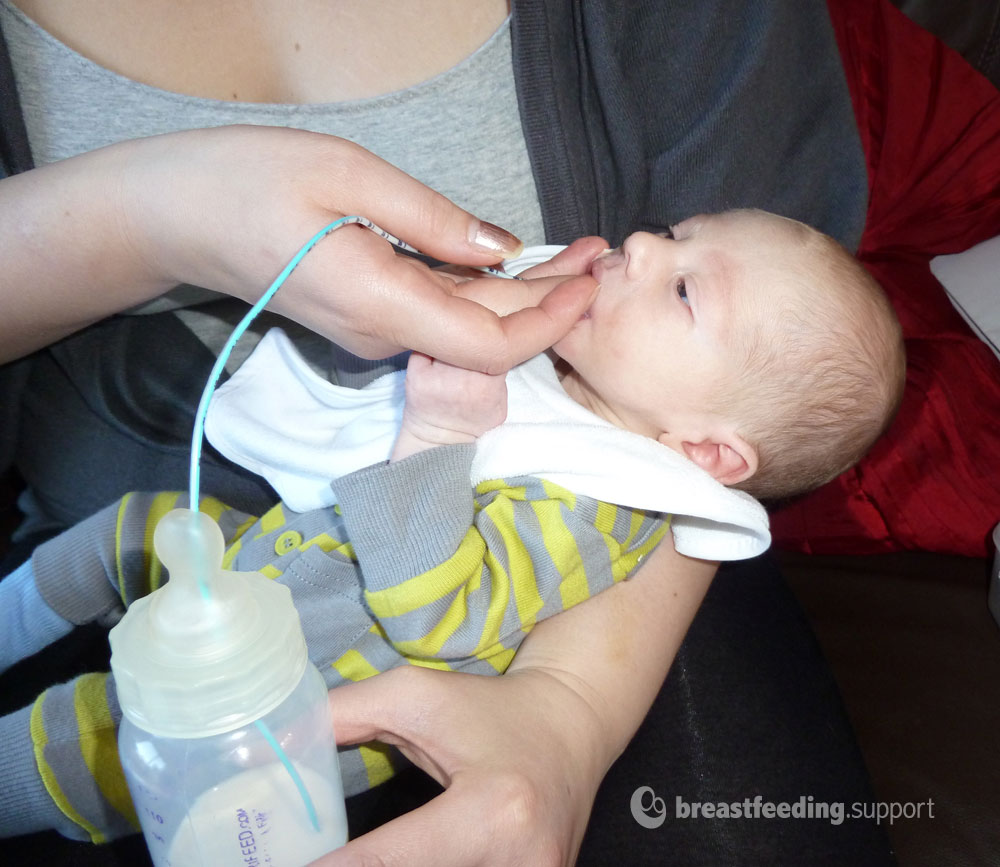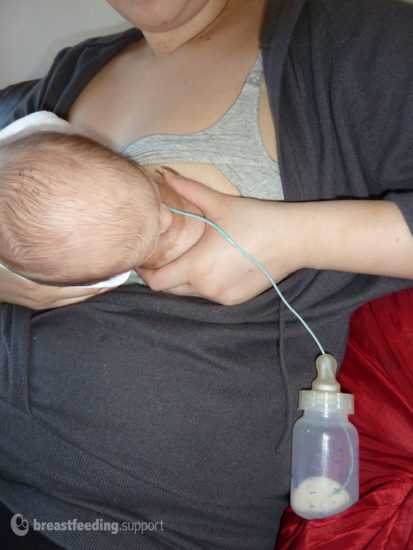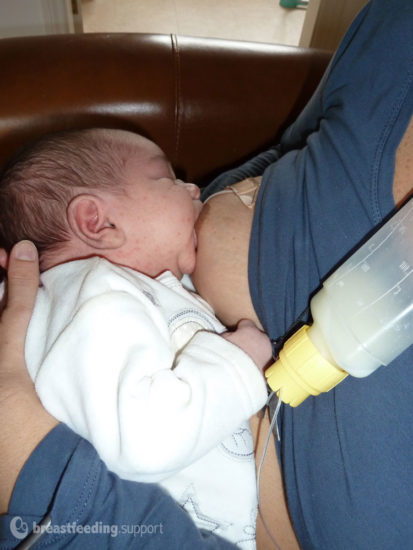Sometimes a baby may need supplemental breast milk, donor milk or formula in addition to direct breastfeeding. There are many possible reasons for low milk supply and if a baby isn’t gaining weight or not gaining enough weight more milk may be needed either temporarily or longer term.
Traditionally supplemental milk has been fed by spoon, syringe, cup-feeding or bottle. But there is another option; supplementing at the breast using a fine feeding tube or supply line. This article looks at how at-breast supplementers work, when to use one, and the pros and cons of supplementing at the breast.
How supplementing at the breast works
Supplementing at the breast requires a container of milk connected to a length of flexible feeding tube. The tube and container may be referred to as an at-breast supplementer, nursing supplementer, lactation aid or a supply line. The free end of the feeding tube is held or taped to run alongside mother’s nipple so that the baby takes the tube and nipple together in his mouth when he latches. Alternatively the tube can be inserted in the corner of baby’s mouth part way through a breastfeed after the breast has been drained. While the baby feeds at the breast, he also receives supplemental milk via the small tube. As long as baby breastfeeds with a good attachment (latch) and suction, with his lips sealed around the breast, milk will flow up the tube with much the same principle as sucking up a straw.
It is a good idea to stay in contact with your IBCLC lactation consultant or health professionals while supplementing at the breast.
Types of supplemental feeding system
There are a few commercial systems on the market, each using different designs and each with their own advantages and disadvantages. It is a good idea to check reviews carefully, ask for recommendations in a supply line support group or your lactation consultant may be able to recommend a good system. It is also possible to make a homemade version, see Homemade Supplemental Nursing System or use a supply line as a finger-feeder. Commercial systems include:
- The Medela Supplemental Nursing System (SNS). This uses a hard sided container for the supplement which hangs from your neck. A tube delivers the supplement from the container to the breast. The feeding tube can be taped to the breast with surgical tape or a sticking plaster. A clip makes it possible to pinch the tube shut to prevent milk flowing. The original model had better reviews and had two tubes leading from the container one for each breast.
- The Lact-Aid. This uses a soft disposable bag to to hold the supplement which also has a neck strap to hang around the neck like the SNS and a clamp to stop milk flow if needed. As with the new Medela System the single feeding tube can be moved between breasts. There are ongoing costs to buy new sterile bags to hold the supplement.
- Haakaa’s Supplemental Feeding Combo. This is available in New Zealand or the Haakaa Supplemental Nursing System is available in the United Kingdom.
- Lactation Hub’s Supplemental Lactation Aid System. Available in USA.
- The Supplemental System Breastfeeding Assist Device. Spotted on Amazon, this looks more like the original Medela model with two tubes but I cannot see any reviews for it.
Controlling the rate of flow of milk
It is important to get the flow of supplement at the right speed—too fast and your baby may get too much milk to cope with. If the flow is too slow, an underweight baby may not have the stamina to keep feeding long enough or at all. Ideally with the supplementer in place, your baby will be having one swallow of milk after every suck or after every two to three sucks for most of the feed. The rate of flow of milk from the supplementer varies with:
- The diameter of the tube—the wider the tube, the faster the flow of milk.
- The position of the container in relation to the baby—the flow is slower if the bottle is positioned below the baby and faster if the container is positioned above baby’s head.
Cleaning a supplemental nursing system
The small feeding tubes are very difficult to clean and will need replacing regularly. Follow manufacturer’s cleaning recommendations very carefully for commercial feeding systems and for information about cleaning homemade versions see Homemade Supplemental Nursing System on this website.

When to use an at-breast supplementer
Supplementing at the breast can be used short term or long term and helps avoid a baby losing interest in breastfeeding prematurely in favour of a bottle. Potential uses include:
- Supplementing a baby if there is a reason for low milk supply including insufficient glandular tissue.
- Keeping an adopted baby fed at the breast to give mother and baby the experience of breastfeeding.
- Keeping a baby interested in latching when encouraging a baby back to the breast after a period of bottle feeding or while a mother is relactating.
- The tube can be used as part of a finger feeding exercise for suck training.
Pros and cons of supplementing at the breast
Advantages
- Baby can get the additional milk he needs at the breast without introducing other feeding methods or techniques.
- Baby gets more practice at breastfeeding well. If baby doesn’t feed correctly, milk won’t come up the tube.
- Mother is able to enjoy the full experience of breastfeeding.
- Helps avoid bottle preference or nipple confusion. There is less chance that a baby will start to prefer a bottle instead of the breast or stop breastfeeding correctly due to nipple confusion with a bottle teat.
- Increases the flow of milk. Supplementing at the breast eliminates a baby’s frustration with slow flow when milk supply is very low.
- The breasts are stimulated to make more breast milk by additional suckling.
- Baby associates feeling full with the breast and this reinforces his desire to breastfeed.
Disadvantages
- It can be difficult and fiddly to use until you get the hang of it, particularly when away from home. An IBCLC lactation consultant can help you get started.
- It is difficult to clean the little tubes thoroughly.
- The system can leak, particularly homemade versions.
- Doesn’t work for all babies. Some babies can’t seem to suck milk up the tube or are not able to get very much. A very underweight baby may still fall asleep at the breast without having fed well. Older babies may be aware of the tube and keep pulling it out.
- Only works with good positioning. It isn’t a suitable method if a baby isn’t latching or is latching so badly as to make his mother’s nipples painfully sore.
- May affect baby’s attachment at breast (latch). Some babies are aware of the tube and it can disturb their latch, tweaking it into different positions may help. Some babies try to suck on the tube like a straw rather than breastfeed correctly.
- The tube could cause gagging if it reaches too far into the baby’s mouth. Taping the tube to the breast with medical tape so that it aligns with the end of the nipple or behind the nipple can avoid this (see “Taping the tube” below)
- Reconstituted powdered formula may clog the tubing.
What supplements can be used with a supply line?
This will depend on your individual circumstances. Supplements could be a mother’s own expressed breast milk, donor milk or formula supplements if needed. Some mothers prefer to use ready made formula as powdered formula may clog the small tubes if it is not well blended. If using powdered formula, use the World Health Organization (WHO) guidelines for safe preparation or the UK’s National Health Service guidelines Making up Infant Formula, NHS, 31 August 2023. And when using expressed breast milk see our storage guidelines. If your baby is underweight, your health professional or IBCLC lactation consultant can guide you with suggested volumes of milk to use in the supplementer. Generally a baby will take as much as they need at any given feeding and this could vary widely depending how much breast milk he is also getting direct from the breast. Staying in contact with your health care team for regular weights will ensure baby is getting enough and growing appropriately.
Taping the tube
The manufacturer’s instructions for one of the commercial systems discuss taping the tube beyond the end of the nipple. However, this might cause a baby to gag or use the tube as a straw instead of breastfeeding correctly. The tube need not extend beyond the mother’s nipple to work. Surgical sticky tape can be used horizontally across the tube or vertically along its length to prevent the tube from slipping. Some mothers use sticking plasters to guide and hold the tubes by slipping the tube under the non sticky portion of the plaster at each feed.
Video of inserting a lactation aid with Dr. Jack Newman
This clip from Dr Jack Newman’s website shows a homemade supplementer being inserted during a breastfeed. Note the baby in this clip looks like he is having to turn his head slightly to reach the breast as he is on his back. Rotating a baby’s body towards his mother to ensure his head and neck are all in a straight line is usually preferable to make swallowing easier for baby. See Homemade Supplemental Nursing System for further information on how to make your own at-breast supplementer.
Video using a commercial supplementation system by Natasha Batsford
Get help with breastfeeding
There are lots of ideas to increase your baby’s intake of breast milk even if you can’t produce a full supply. See How to Make More Breast Milk and contact your IBCLC lactation consultant for more support. Your lactation consultant can help you find the best latch and position for you and your baby, check your baby’s tongue function, and help with breastfeeding management.
Summary
An at-breast supplementer or supply line allows a baby to take top ups of supplemental milk directly at the breast while breastfeeding. Supplementing this way has various pros and cons but is another option to consider alongside bottles or cup feeding. A very underweight baby who has not been gaining weight can still tend to fall asleep at the breast without having swallowed plenty of milk, even with a supplemental tube in place. It is important to monitor weight gains and dirty nappies to establish whether your baby is getting enough milk. Stay in contact with your IBCLC lactation consultant or health professionals while supplementing at the breast using a lactation aid.

